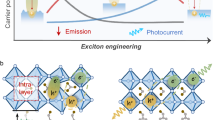Abstract
Optical fibres doped with lanthanide or transition-metal elements can serve as in-line lasers and amplifiers for fibre-optic telecommunications systems. In general, most such fibre lasers use conventional silica-glass fibres doped with erbium or neodymium. But silicon dioxide absorbs strongly in the infrared for wavelengths of greater than 4 µm or so, limiting the infrared range over which such lasers can operate. Some other oxide materials do not absorb significantly until longer wavelengths—the absorption coefficient of crystalline silica at 4 µm is equal to that of yttrium oxide at 7.1 µm and of sapphire (a form of alumina) at 5.1 µm, for example1. Glass fibres made from these materials would therefore expand the range of fibre lasers into the mid-infrared. But molten oxides that do not contain silica typically have a viscosity too low to support fibre-pulling processes. Here we demonstrate that containerless processing, in which a molten sample is levitated by a flow of inert gas, permits sufficient undercooling of molten yttrium aluminium garnet (YAG:Y3Al5O12) to access a viscosity range conducive to fibre-pulling. The process is particularly effective if the molten material of stoichiometric YAG composition is doped with Nd2O3 in place of Y2O3, or with excess Al2O3; and it should also work with other dopants, because molten oxides are good solvents. Fibres could be drawn from a melt doped with Er2O3 in the presence of excess Al2O3. These fibres have the potential to extend the operating range of oxide glass-fibre lasers.
This is a preview of subscription content, access via your institution
Access options
Subscribe to this journal
Receive 51 print issues and online access
$199.00 per year
only $3.90 per issue
Buy this article
- Purchase on Springer Link
- Instant access to full article PDF
Prices may be subject to local taxes which are calculated during checkout



Similar content being viewed by others
References
Bass, M. (ed.) Handbook of Optics Vol. 2, Devices, Measurements and Properties2nd edn (McGraw-Hill, New York, 1995).
Angell, C. A. in Relaxations in Complex Systems(eds Ngai, K. L. & Wright, G. B.) 3–11 (National Technical Information Service, US Dept of Commerce, Springfield, VA, 1985).
Angell, C. A. Formation of glasses from liquids and biopolymers. Science 267, 1924–1935 (1995).
Debenedetti, P. G. Metastable Liquids(Princeton Univ. Press, 1997).
Fratello, V. J. & Brandle, C. D. Physical properties of a Y3Al5O12melt. J. Cryst. Growth 128, 1006–1010 (1993).
Massiot, D., Taulelle, F. & Coutures, J. P. Structure diagnostic of high temperature liquid phases by 27Al NMR. Colloque Phys. C 5, 425–431 (1990).
Weber, J. K. R. & Nordine, P. C. Containerless liquid-phase processing at high temperatures. Microgravity Sci. Technol. VII, 279–282 (1995).
Weber, J. K. R., Felten, J. J. & Nordine, P. C. New method for high purity ceramic synthesis. Rev. Sci. Instrum. 67, 522–524 (1996).
Loewenstein, K. L. The Manufacturing Technology of Continuous Glass Fibres(Elsevier, Amsterdam, 1973).
Laughlin, W. T. & Uhlmann, D. R. Viscous flow in simple organic liquids. J. Phys. Chem. 76, 2317–2325 (1972).
Abell, J. S., Harris, I. R., Cockayne, B. & Lent, B. An Investigation of phase stability in the Y2O3-Al2O3system. J. Mater. Sci. 9, 527–537 (1974).
Caslavsky, J. L. & Viechnicki, D. J. Melting behavior and metastability of yttrium aluminum garnet (YAG) and YAlO3 determined by optical differential thermal analysis. J. Mater. Sci. 15, 1709–1718 (1980).
Aasland, S. & McMillan, P. F. Density-driven liquid-liquid phase separation in the system Al2O3-Y2O3. Nature 369, 633–639 (1994).
Acknowledgements
We thank P. F. McMillan and C. A. Angell for discussions. This work was supported by NASA. B. Cho was partially supported by the State of Illinois, USA.
Author information
Authors and Affiliations
Corresponding author
Rights and permissions
About this article
Cite this article
Weber, J., Felten, J., Cho, B. et al. Glass fibres of pure and erbium- or neodymium-doped yttria–alumina compositions. Nature 393, 769–771 (1998). https://doi.org/10.1038/31662
Received:
Accepted:
Issue Date:
DOI: https://doi.org/10.1038/31662
This article is cited by
-
Experiments to understand crystallization of levitated high temperature silicate melt droplets under low vacuum conditions
Scientific Reports (2020)
-
Predictive multiphase evolution in Al-containing high-entropy alloys
Nature Communications (2018)
-
Mesoscale engineering of photonic glass for tunable luminescence
NPG Asia Materials (2016)
-
Deviation from high-entropy configurations in the atomic distributions of a multi-principal-element alloy
Nature Communications (2015)
-
Levitating liquids
Nature Materials (2008)
Comments
By submitting a comment you agree to abide by our Terms and Community Guidelines. If you find something abusive or that does not comply with our terms or guidelines please flag it as inappropriate.



